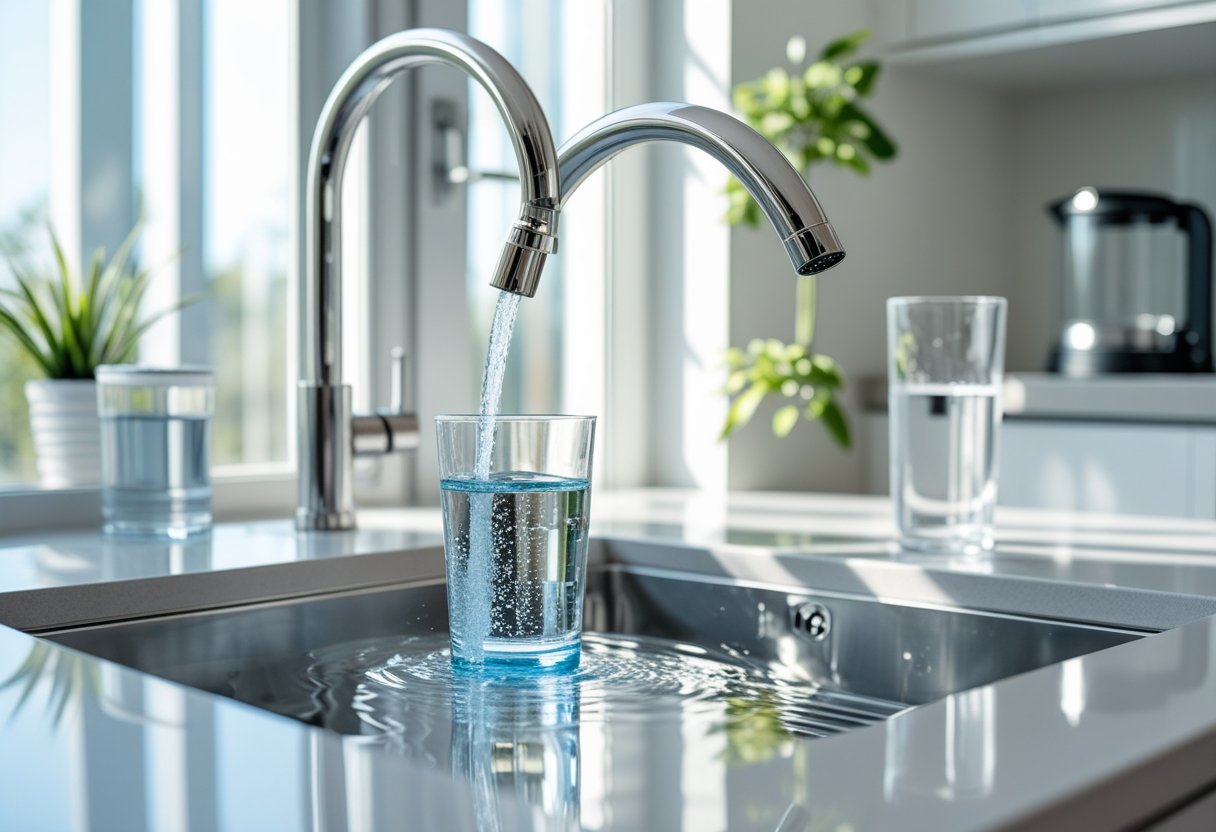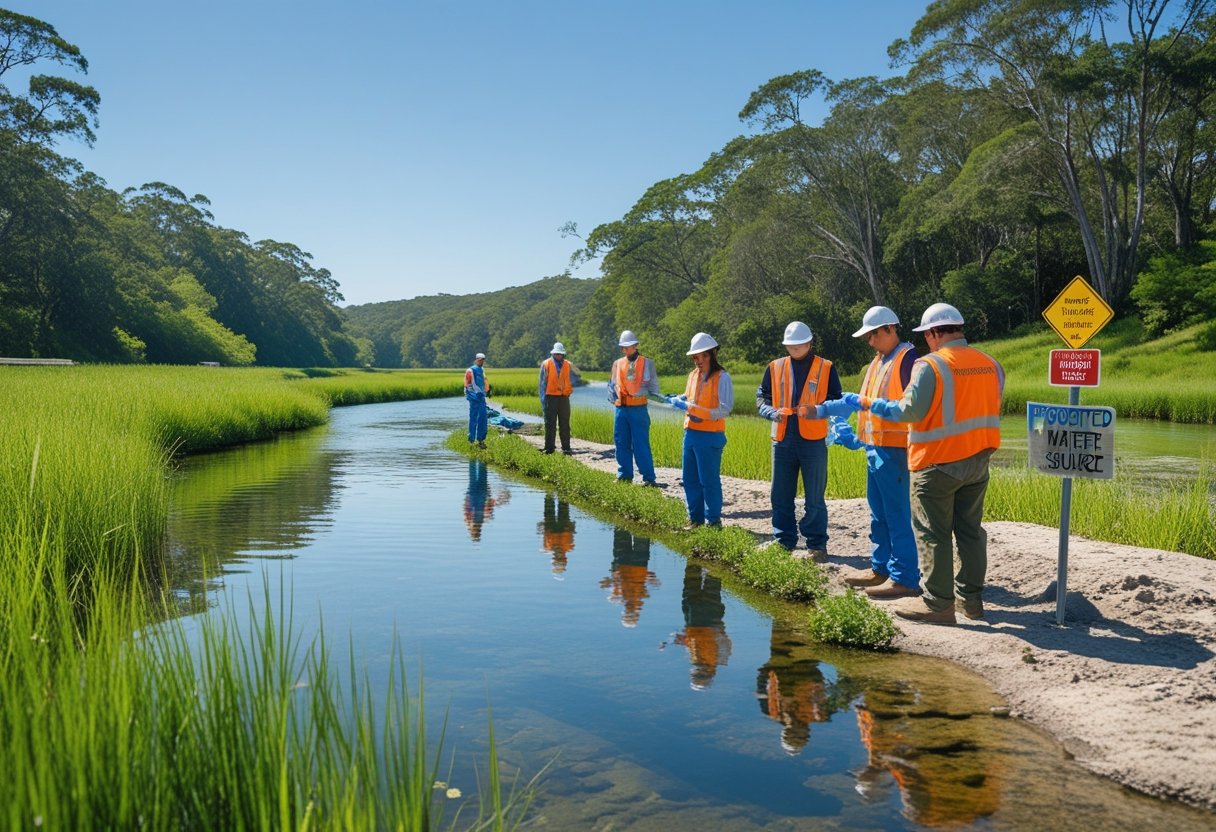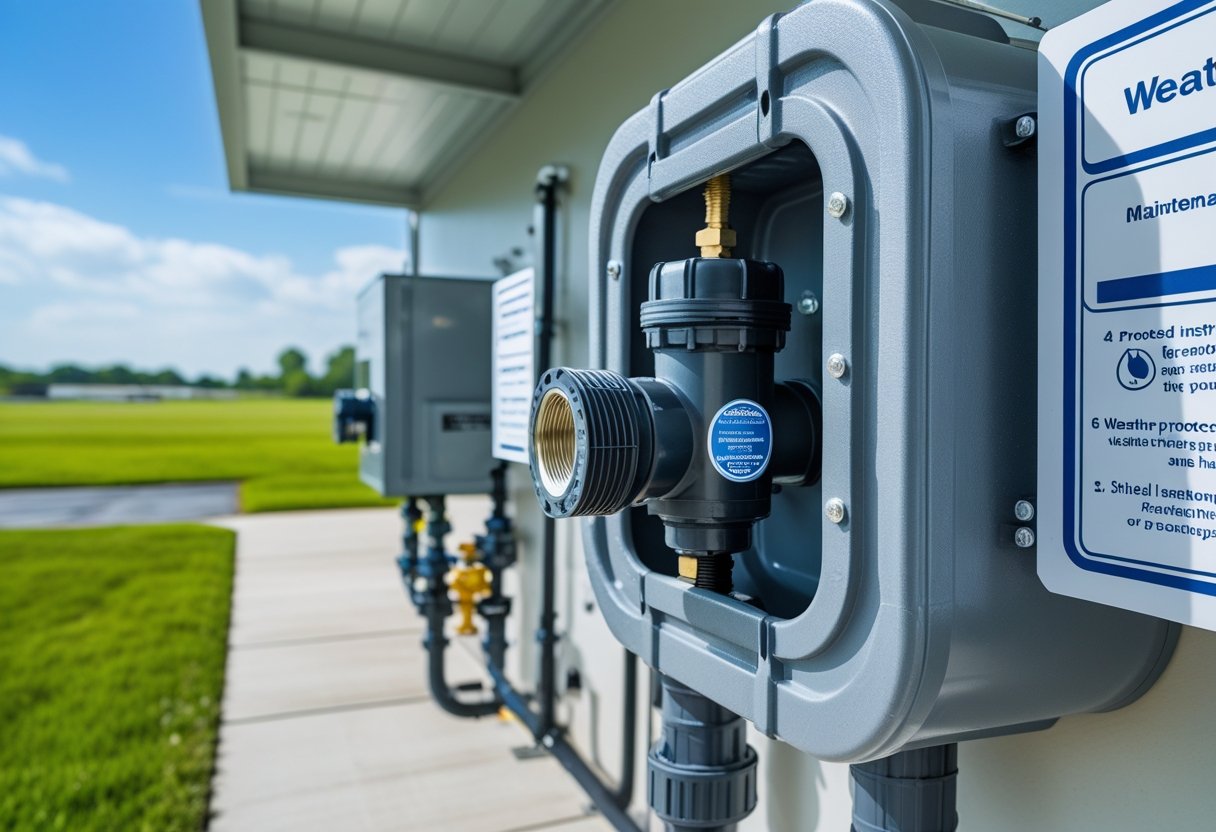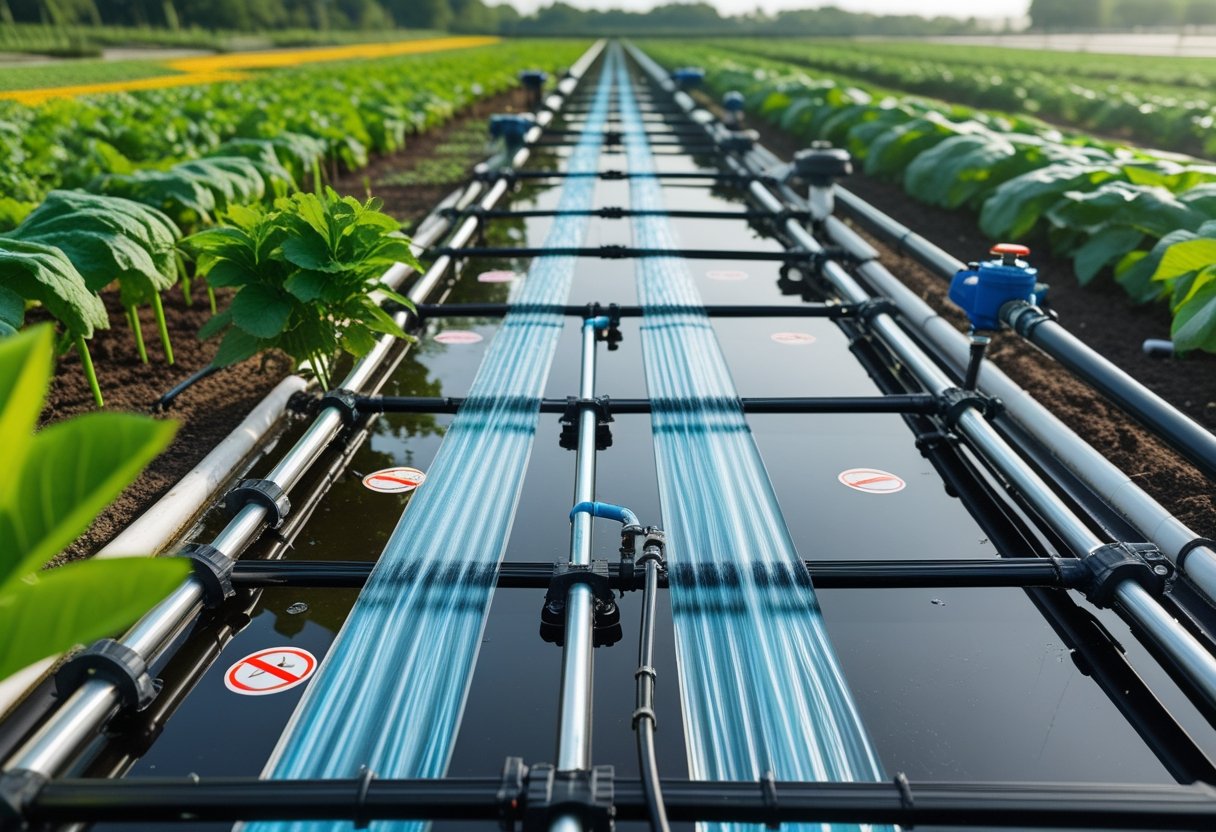Knowing the quality of the water in your home is important to keep your family safe and healthy. Water quality testing helps you find out if your water is clean and free from harmful contaminants that could cause illness or damage to your plumbing.
By testing regularly, you can catch problems early. This helps make sure your water supply meets local rules.
Testing your water often includes checking backflow prevention devices. These devices stop dirty water from flowing back into your clean water supply.
If backflow devices aren’t working right, your water could get contaminated. Annual backflow testing keeps your system working and helps you avoid health risks or fines.
Skilled technicians can help with testing, repairs, or new installations. They make it easy to protect your home’s water supply.
Understanding Water Quality
Water quality affects your health, your home’s safety, and your daily life. Knowing what might be in your water and why it matters helps you protect your family and property.
Why Water Quality Matters for Homeowners
Your home’s water supply should be clean and safe to use. Poor water quality can cause health problems like stomach illness or skin irritation.
It can also damage your plumbing and appliances over time. Testing your water helps you find harmful substances early.
Fixing problems protects your family and avoids costly repairs. Certain local laws require you to test your water or backflow devices yearly to keep it safe from contamination.
Common Contaminants Found in Home Water
Some common water contaminants you might find include:
- Bacteria and viruses: Can cause illness.
- Lead and heavy metals: Harmful if consumed in large amounts.
- Chemicals like pesticides: Can enter water from nearby farms or yards.
- Sediments: Dirt or rust that can cloud water and harm pipes.
These problems can come from old pipes, pollution, or cross-connections in your plumbing. Knowing what’s in your water helps you choose the right treatment or repairs.
Safe Water Standards
Safe water standards are rules that make sure water is clean and healthy. These rules set limits for how much of certain chemicals or germs can be in your water.
Your local water agency and health departments require testing of backflow preventers every year. This protects your water by stopping polluted water from flowing backward into clean pipes.
Meeting these standards keeps your water safe to drink, cook with, and bathe in. If your water doesn’t meet standards, you need fixes like backflow device repairs or replacements to stay safe and follow the law.
Signs Your Water Needs Testing
Your water might look, taste, or smell different than usual. You could also notice health problems that start after drinking or using your water.
These are reasons you should test your water to keep your home safe.
Visible Changes in Water
If your water looks cloudy, has particles, or unusual colors like brown, yellow, or green, get it tested. Rusty or discolored water can mean old pipes or contamination from metals.
You might also see floating debris or sediment. This can come from old plumbing or water source issues.
Sometimes water can appear oily or have a film on top. This is a sign of chemical contaminants.
Keep an eye on changes in water clarity or color. These are the easiest warning signs.
Unusual Odors or Tastes
Water that smells like rotten eggs or sulfur needs checking right away. This odor often comes from bacteria or gas contamination.
If your water tastes bitter, metallic, or salty, chemicals or minerals may be out of balance. Water should usually taste fresh or neutral.
Chlorine smell is normal in treated water, but strong chemical or fuel-like odors are signs of trouble. Be cautious if your water tastes odd, as that might indicate a safety issue.
Health Symptoms Related to Water Quality
If you or your family get sick often with diarrhea, cramps, nausea, or vomiting, bad water might be the cause. These symptoms are common if bacteria, viruses, or parasites contaminate your supply.
Skin rashes or irritation after washing can also be a sign of poor water quality. Pets can get sick too, so watch how your animals react after drinking well water.
If you notice these health problems, test your water quickly to find out if it’s safe.
Types of Water Quality Tests
Testing your water helps you know if it’s safe to drink and what kinds of contaminants might be present. You can test water yourself at home or send it to a lab for detailed analysis.
There are also digital devices that give quick results and track changes over time.
Basic At-Home Test Kits
At-home test kits are easy to use and give quick results for common issues like bacteria, chlorine, pH, and hardness. They usually include test strips or small containers where you add a water sample.
These kits are affordable and good for checking simple problems. They don’t catch all contaminants.
Their results can sometimes be less accurate compared to professional testing. Use at-home kits to spot obvious concerns, but follow up with lab tests for a full safety check.
Some kits test for only one or two issues, so choose one that fits your needs.
Laboratory Water Testing
Lab testing is the most detailed way to check your water. You collect a sample and send it to a certified lab, where experts run tests for bacteria, heavy metals, chemicals, and more.
Labs can detect very low levels of contaminants. Results usually take several days to get back.
Professional labs follow strict rules to ensure accuracy. You’ll receive a detailed report explaining what was found and if your water meets safety standards.
Digital Water Testing Devices
Digital devices offer fast, repeatable water quality checks with easy-to-read displays. Many measure pH, total dissolved solids (TDS), and conductivity.
You can keep one handy to test your water regularly or after a suspected problem. Some models store data so you can track changes over time.
Digital testers are more precise than strips, but they may not detect all chemicals or bacteria. For that, lab testing is still necessary.
Digital tools are great for quick checks and ongoing monitoring.
How to Collect Water Samples
Collecting water samples properly is important to get accurate test results. You need to use the right tools and avoid contamination.
Keep your samples labeled and stored correctly. These steps help you know exactly what is in your water.
Proper Techniques for Sample Collection
Use clean containers made for water testing, usually provided by labs or stores. Before you collect, flush the water for about 2 minutes to clear out pipes.
Fill the container slowly to avoid bubbles or splashes. Make sure to collect from a cold water source.
If testing well water, take the sample directly from the well or a clean tap connected to it. Avoid taps with filters or aerators, as these can change the results.
Wear clean gloves if possible. Do not touch the inside of the container or the cap.
Close the container tightly once filled to avoid spills or outside air getting in.
Avoiding Contamination
Never use containers that previously held chemicals or other liquids. Rinse the container only if instructed—some samples require an untouched container.
Keep your hands and gloves clean during sampling. Collect your samples away from sinks, drains, or bathrooms to lower the chance of contamination.
Do not let the container touch the faucet or any surface. Avoid coughing, sneezing, or talking over the sample while collecting.
This prevents bacteria or other particles from entering. After filling, wipe the outside of the container with a clean towel if needed.
Labeling and Storing Samples
Label your sample right after collecting. Include the date, time, and exact location of the water source.
This helps track your samples and avoids mix-ups. Use a waterproof marker or a printed label.
Store samples in a cool place, ideally a cooler with ice packs, especially if you won’t deliver them to the lab immediately. Do not freeze the sample unless instructed, as this can damage it.
Try to get your sample to the lab quickly, usually within 24 hours. The fresher the sample, the more accurate the test results will be.
Keep samples away from direct sunlight and heat while transporting.
Interpreting Water Test Results
Understanding your water test results helps you know what is in your water and if it’s safe to use. You’ll see numbers and terms that can be confusing.
Knowing what these readings mean and what to do if there are problems is very important.
What Different Readings Mean
When you get your water test report, it usually shows levels of things like bacteria, nitrates, lead, and other chemicals. Each contaminant has a safety limit set by health guidelines.
If your numbers are below these limits, your water is generally safe.
For example:
ContaminantSafe LimitWhat High Levels Mean Bacteria0 CFU/100mLRisk of illness from germsNitrates10 mg/LCan cause health problems, especially for babiesLead0.015 mg/LLinked to serious health issues
If your results show “not detected” or values well below the limit, your water is likely safe. If the numbers are higher, that means a possible problem.
Dealing with Positive Contaminant Results
If your test shows levels above the safe limits, don’t panic. Confirm with more tests, since sometimes errors happen.
You can contact a local water expert or lab to help. Next, consider treatment options.
For bacteria, disinfecting your water with chlorine or using a UV filter can help. For chemicals like lead or nitrates, a water filter designed for those contaminants may be needed.
Stay informed about local water quality, since some problems come from the source or plumbing. Regular testing is a smart habit to keep your water safe.
Solutions for Common Water Quality Issues
Improving your water quality often means tackling specific problems like contaminants, bacteria, or mineral buildup. You can use filters or purification systems.
Disinfect your water if it’s infected, and manage hard water issues to protect your pipes and appliances.
Filter and Purification Options
You can use various filters to remove pollutants like lead, bacteria, and chemicals from your water. Activated carbon filters are great for removing chlorine and odors.
Reverse osmosis systems provide deeper cleaning by removing metals and many dissolved solids. For bacteria and parasites, UV purification or ceramic filters work well.
These options don’t use chemicals but kill or block harmful microbes. Test your water first to know what you need.
Change or clean filters regularly to keep your system working well and your water clean.
Shock Chlorination
If your water supply is infected with bacteria or other harmful microorganisms, shock chlorination can disinfect your system. This involves adding a strong chlorine solution to your pipes to kill germs.
Only do shock chlorination after testing confirms bacteria. Be careful with the dosage and follow safety steps to avoid damage to pipes or health risks.
After treatment, flush the system thoroughly until the chlorine smell is gone. This method helps ensure your water is clean and safe again.
Addressing Hard Water Problems
Hard water has high levels of minerals like calcium and magnesium, which cause scale buildup inside pipes and appliances. This reduces their efficiency and lifespan.
You can install a water softener to remove these minerals. Water softeners replace calcium and magnesium with sodium, reducing scale and improving water flow.
Regularly flushing your pipes helps prevent buildup too. If you live in a hard water area, check your system every 6 to 12 months to keep everything running smoothly.
Maintaining Water Quality in the Home
Keeping your water safe means testing it regularly and taking care of your water system. These simple actions help you catch problems early and keep contaminants out.
You’ll protect your health and avoid costly repairs.
Regular Testing Schedule
Testing your water once a year is a good rule to follow. This helps you spot contaminants like bacteria, chemicals, or heavy metals before they cause harm.
Use a reliable home water quality test kit or hire a professional when you test. Certified technicians can perform more detailed tests for contaminants you might not detect yourself.
Keep track of your results and compare them to safety standards. If your test shows anything above safe levels, plan for follow-up testing or treatment.
Some water districts require backflow preventer testing annually to ensure your system stays safe and complies with local rules. Scheduling tests yearly helps you stay on top of your water’s quality.
Ongoing System Maintenance
Maintaining your water system means regular checks and prompt repairs. Backflow preventers play a big role in stopping dirty water from mixing with your clean supply.
Have your backflow preventer inspected and serviced yearly to make sure it works well. If there’s a leak or it fails a test, repair or replace it quickly.
Delays can let contaminants enter your water system. Don’t forget other parts of your plumbing, like filters and pipes.
Clean or replace filters as recommended. Protect your system from damage by keeping equipment secure and avoiding tampering.
These steps keep your water cleaner and safer to use every day.
Professional Help for Water Testing
Getting professional help ensures your water testing meets local rules. Experts can spot problems early and handle complicated equipment like backflow preventers.
Knowing when to call a pro and picking the right service can save you time and stress.
When to Call an Expert
Call a water testing expert if you notice strange tastes, smells, or cloudiness in your water. If your home has older plumbing or uses well water, professionals can do thorough tests you can’t do at home.
Annual backflow testing is often required by law to keep your water safe. Experts check parts inside the preventer that wear out over time.
If a test shows problems, they can repair or replace the device to stop contamination. Emergencies like leaks in your backflow preventer need fast service.
Certified techs can respond quickly to avoid damage and keep your water supply protected.
Choosing a Water Testing Service
Look for a water testing company with experience and good reviews. Check that they are certified and follow local regulations for backflow testing and reporting.
Ask if the company handles all steps, from scheduling your test to filing results with the city. Some services also offer repairs, installations, and protection cages if you need extra help.
Compare costs but don’t pick only based on price. Reliable service means fast, hassle-free testing and clear communication.
Pacific Backflow, for example, serves San Diego County with over 40 years of experience. They test, repair, and replace backflow preventers, file reports, and even offer emergency services.
Choosing a trusted company like them helps keep your water safe and your system compliant.
Understanding Local Water Sources
Knowing where your water comes from is key to keeping it safe and clean. Different sources can affect water quality in different ways.
You also need to pay attention to activities near your water supply that might change its safety.
City Water vs. Well Water
City water is treated and tested regularly by municipal authorities. It usually meets strict safety standards before it reaches your home.
This means you get water that is generally safe to drink without extra treatment. Well water, on the other hand, comes directly from underground sources on your property.
Local governments do not treat well water, so you are responsible for testing it regularly. Well water can contain natural minerals or contaminants like bacteria, depending on where your well is located.
If you use well water, regular testing is even more important. Testing checks for issues like bacteria, nitrates, or chemicals that might be harmful.
Impact of Nearby Activities on Water Quality
What happens near your water source affects the quality of your water. Farming, industrial facilities, and construction sites can introduce pollutants such as pesticides, chemicals, or sediments into the water.
Pesticides from farming can seep into groundwater or run off into city water supplies. Industrial waste may introduce chemicals if not managed properly.
Even old pipes or poorly maintained systems near your home could cause contamination like backflow, allowing dirty water to mix with clean water. Keeping an eye on nearby land use and getting regular water testing helps you catch any problems early.
It also means you can protect your family by fixing risks before they affect your drinking water.
Staying Informed and Safe
Knowing the quality of your home’s water helps keep you and your family healthy. Regular water testing lets you catch issues like contaminants early.
You can use home test kits or hire professionals who know exactly what to look for. Backflow testing is a key part of keeping your water safe.
It stops dirty water from flowing back into your clean water supply. You are usually responsible for making sure backflow tests happen on time.
Many local areas require annual testing by law. Here’s how you can stay on top of it:
- Schedule yearly backflow tests with a trusted company.
- Fix problems quickly if your backflow device fails testing.
- Keep records of inspections and repairs for easy access and proof.
- Protect your backflow equipment with cages to stop theft or damage.
If you need help, a company with experience can handle testing, repairs, installations, and even emergencies. They can also file all reports for you, so you don’t have to worry about paperwork.
Frequently Asked Questions
Testing your water for safety and contamination is key to protecting your home and family. There are many ways to check for contaminants, from simple kits to professional services.
Costs, locations, and options vary depending on your needs.
What options do homeowners have for testing their water quality?
You can use home test kits that check for lead, bacteria, nitrates, and other common pollutants. These kits are easy to find at stores and online.
For more detailed results, you can send water samples to certified labs.
How can I test my home water quality without a kit?
You can watch for signs like changes in taste, smell, or color. Also, check local water quality reports or ask your water supplier about recent tests.
These clues can help you decide if more testing is needed.
Are there any free water testing services available for homeowners?
Some local health departments or water utilities offer free or low-cost testing. It depends on your area.
Contact your city or county health agency to see if they provide this service.
What are the best methods for evaluating residential water quality?
Professional lab testing is the most accurate. Home test kits can give quick results for specific contaminants.
Combining both methods is a good way to keep your water safe.
Where can I find reliable water testing services near me?
Look for certified labs or companies with good local reviews. Some companies also offer backflow testing and repairs, which help protect your water supply.
You can ask neighbors or check online directories.
How much can I expect to pay for a professional water quality test?
Costs usually range from $50 to $300. The price depends on the specific tests you need.
Some companies include testing with inspections or repairs. Always ask for a clear price estimate before you begin.











